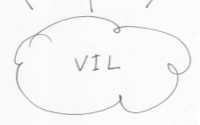First the place where I live. The house with the red-rimmed 10 ft trampoline is my place. The view on the harbor is a bit different now, since the hilly surrounding which you see on the old Google Map, is now also occupied by may be 40 houses, gardens and children.
You can see that we have all sources available: sun, water and wind (the last one is the hardest to see).
Per household we use - in avarage - about 3500 kWh electricity and 46 GJ heat per year:
3500 kWh : € 960 per year
46 GJ : € 1352 per year
Total : € 2312 per year
Okay, lets lining up two basic alternatives (faeces for gas production is excluded):
- Heat pump plus wind generator, solar cells or hydro generator. A heat pump uses electricity to gain heat from air, water or soil. About 25% electricity is needed for 100% heat. Eventually by solar collector pre heating we can save heat pump electricity.
- A micro heat and power station uses diesel or geo thermal heat to drive a stirling motor which again drives a generator for electricity. The waste heat is used for hot water and heating. Although this alternative is coming up, the geo thermal variant is still expensive. And of course we want to be eco friendly, so no diesel.
Electricity however is very suitable to produce on a centralised place. Which makes the use of hydro energy somewhere in the port, wind energy with one big TransKite or solar energy cells somewhere in space suitable.
Okay okay relax, we of course will use solar cells on roofs.
But in essence that IS the problem with renewable energy sources. The energy concentration of sun light, wind or water is very low, which means that we need a lot of collectors to gain enough energy. Which again means that we need (too) much material (steel, aluminium, plastic (=oil) etcetera), which is for the whole world not available!! Andre Diederen (TNO) wrote a book about this theme, called the global resource depletion, nice theme.
So what source are we going to use to feed our heat pump and of course our fridge too?
Wind: small household wind turbines like the Turby are very expensive, € 50 till € 100 per kWh per year, and not efficient. A wind turbine twice as big needs twice the material but gains four times the energy. So from an ecological and financial perspective not very attractive.
But, but there are other turbines than wind mills like the TransKite said the fool, and Magenn zeppelins.
The Magenn zeppelin
They can gain wind energy on higher levels where the energy concentration is much higher and more constant. On an altitude of 5 kilometer there is always wind and 30 times more per square meter than on 10 meter.
The Magenn Zeppelin operates on 300 meter and costs only € 0,43 per kWh per year, but you need to buy a big one, which delivers about 850.000 kWh per year here at my place, so with 3500+3200 kWh per household we need 127 households to join.
Regarding sun and water: solar cells can be used but are expensive, about € 5 per kWh per year and hydro turbines will cost approximately € 3 per kWh per year. Hydro turbines may also cost a little bit of cooperation of the port authorities which might be not very obvious.
So the best option would be a Magenn zeppelin for 127 households combined with a number of heat pumps. The investment (lifecycle about 15 years) per household would be:
Magenn zeppelin : € 2.880
Heat pump : € 7.500
Total : € 10.380
Lets add 20% maintenance costs, then it would be € 830 per year for both and € 500 for the heat pump alone.
Eeh, of course we could also buy the electricity from the local provider in stead of using the Magenn zeppelin. That would cost about € 1660 per year for 6700 kWh, over a period of 15 years about € 24.880 (prices of 2010) which is eight times more than the zeppelin. Together with the heat pump it would be € 2160 per year.
Lets finally put the yearly costs in a graph :
Well, nothing more to say...

































